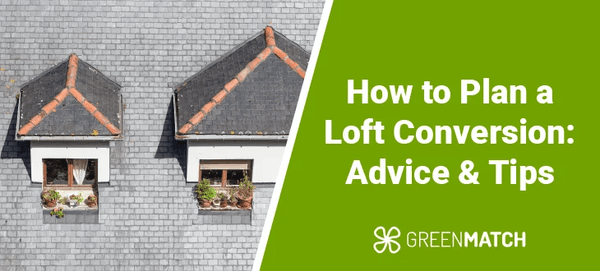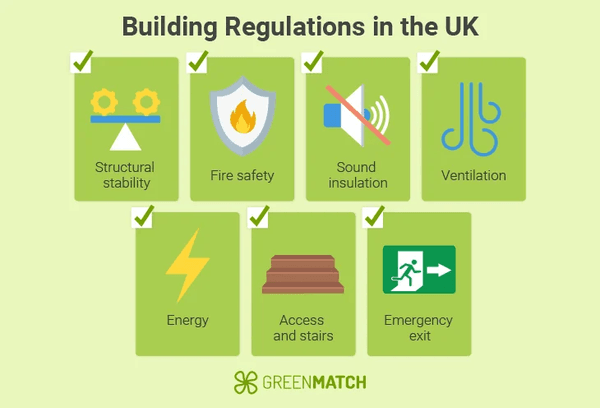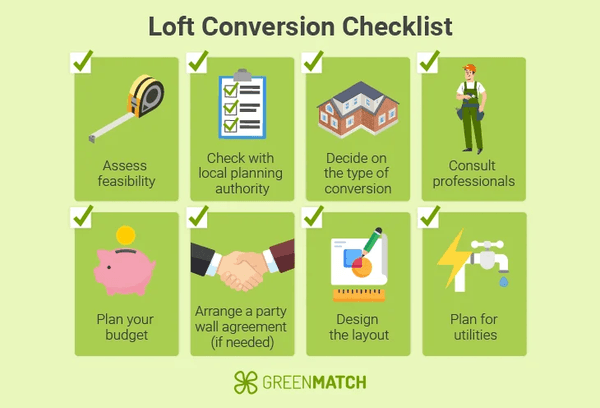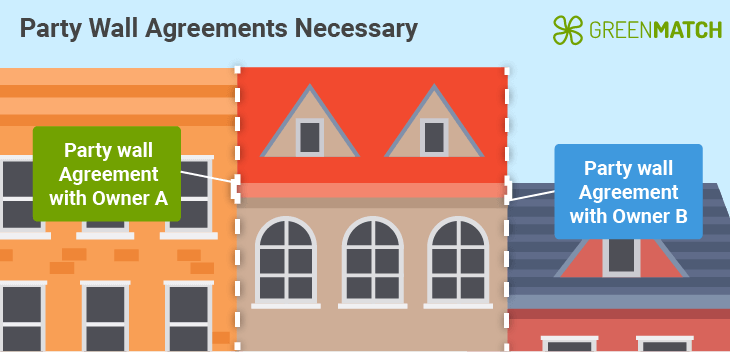Answer these simple questions and we will find you the BEST prices
Which type of solar quotes do you need?
It only takes 30 seconds
100% free with no obligation

Get Free quotes from loft conversion specialists near you

Save money by comparing quotes and choosing the most competitive offer

The service is 100% free and with no obligation
- GreenMatch
- Loft Conversion
- Advice & Tips
How to Plan a Loft Conversion: Advice & Tips


- Ensure your roof has the height and structural integrity for a loft conversion.
- Don’t risk delays—get planning permission if needed and make sure your plans meet all building regulations.
- Compare quotes from top contractors to guarantee the best value for your investment.
Planning a loft conversion can feel overwhelming, especially when you’re not sure where to start. Questions like "Is my roof suitable?" or "Do I need planning permission?" can leave you uncertain and hesitant to move forward. But with the right guidance, turning your loft into a valuable living space is simpler than you think.
This guide will walk you through every step of the process, from assessing your loft’s suitability to finding the right professionals. By the end, you’ll have a clear path forward, making your loft conversion is a smart, manageable investment in your home.
Save time by filling out the form below to quickly request up to 3 quotes from trusted local specialists. Start planning your project today without the hassle of searching for quotes. Click below to begin!
- Describe your needs
- Get free quotes
- Choose the best offer
It only takes 30 seconds



How to plan a loft conversion
When planning a loft conversion process, the first step is assessing the existing structure. This involves checking the height and pitch of your roof, as well as the strength of the floor joists.
You’ll need a minimum head height of 2.2 metres for comfortable living space, and strengthening the floor might be necessary to support the new room. Hiring a structural engineer or architect at this stage is crucial for a precise assessment.
Next, consider legal requirements. You may need planning permission, particularly if you live in a conservation area or your property is a listed building.
Ensure your conversion complies with UK building regulations, which cover aspects like fire safety, insulation, and structural integrity. Planning ahead by consulting professionals can save you time and prevent costly mistakes.

Use eco-friendly materials and install high-quality insulation to boost energy efficiency. You can also think about installing solar panels to reduce your environmental impact.
Steps involved in loft conversion planning
Planning for loft conversion requires careful consideration and a methodical approach to ensure everything runs smoothly. Following this loft conversion checklist will help you stay on track and make informed decisions throughout the process:

- Assess feasibility: Measure your roof’s head height, check the pitch, and evaluate the strength of your floor. Ensure there’s enough space and structural capacity to support a loft conversion.
- Check with local planning authority: Determine if you need planning permission, especially if you are having a loft conversion in a listed building or conservation area. Not all loft conversions require this, but it's essential to confirm.
- Decide on the type of conversion: Choose between a dormer, mansard, hip-to-gable, or roof light conversion. The right option depends on your roof structure, budget, and the type of space you want to create.
- Consult professionals: Hire an architect or structural engineer to draft plans and ensure your conversion meets building regulations for safety, insulation, and fire protection.
- Plan your budget: Set a realistic budget, factoring in structural work, labour costs, materials, and any necessary permissions or fees. It’s wise to include a contingency for unexpected expenses.
- Arrange a party wall agreement (if needed): If your property shares walls with neighbouring homes, you’ll need a party wall agreement to inform them of the work and avoid disputes.
- Design the layout: Work with your architect to design a functional and practical layout that maximises the available space and suits your needs. Think about storage, natural light, and access points like staircases.
- Plan for utilities: Don’t forget to plan for heating, electrical wiring, plumbing (if adding a bathroom), and insulation. This will ensure your loft conversion is comfortable and energy-efficient year-round.
As you can see, the planning process is quite involved, and you might be wondering, "Is a loft conversion worth it?"
Converting a loft is a great way to add space and increase property value, often more cost-effective than moving. It can be tailored for various uses, like a bedroom or office.
However, poor planning can lead to extra costs, so it's crucial to consult specialists early to ensure a smooth and successful project and to avoid unexpected increases in the overall cost of a loft conversion.
When choosing contractors, getting quotes from at least 3 specialists isn’t just a good idea—it’s essential. Here’s why:
- Accurate cost comparison: Contractors may offer different prices for the same work. Getting multiple quotes helps you avoid overpaying and gives you a clearer idea of market rates.
- Assess quality of service: It’s not just about price. Quotes allow you to evaluate a contractor's communication, experience, and overall value. Choose those who are transparent and detailed in their approach.
- Spot red flags: A quote that’s too low may signal poor quality or shortcuts. Comparing quotes helps you identify contractors who comply with regulations and maintain quality standards.
- Leverage for negotiation: Multiple quotes give you the power to negotiate better terms, such as extended warranties or faster timelines. Contractors are more flexible when they know you’re weighing options.
By taking the time to compare multiple quotes, you’ll secure the best possible deal for your loft conversion, saving money while ensuring top-quality results.
Don’t leave this important step to chance—fill in the form now to get up to 3 quotes from trusted local installers. This way, you can confidently move forward with your project, knowing you're making a smart and informed investment. Click below to begin!
- Describe your needs
- Get free quotes
- Choose the best offer
It only takes 30 seconds



Tips for planning a successful loft conversion
By following the loft conversion tips below, you’ll be better equipped to handle the challenges of loft conversion and ensure a smoother, more successful outcome:
- Budget carefully: Set a clear budget from the start, covering all expected costs, including labour, materials, and permissions. Track spending closely to avoid overruns.
- Set a 10% contingency: Always allocate at least 10% extra in your budget to cover unexpected issues, such as structural surprises or material delays. This prevents last-minute financial stress.
- Prepare for delays: Building projects often experience delays due to weather, supply shortages, or unforeseen issues. Have realistic expectations about the timeline and be prepared for potential setbacks.
- Plan for disruption: Loft conversions can disrupt your daily life with noise, dust, and restricted access. Make arrangements to minimise the impact on your routine, especially if you’ll still be living in the house during the build.
- Ensure proper ventilation and insulation: Proper ventilation and insulation are essential for making the loft space comfortable and energy-efficient. Plan these elements early to avoid issues like dampness or excessive heating costs later on.
- Consider future-proofing: Think long-term when planning your loft conversion. Will the space still meet your needs in the future? Consider flexible layouts or adding plumbing for a potential bathroom even if you don’t need one right away.
- Check access requirements: Make sure you have a practical and compliant staircase design for easy access to the loft. A well-planned staircase is crucial to both safety and convenience.
- Notify your neighbours: If you share walls with neighbours, notify them early and, if necessary, arrange for a party wall agreement. This ensures everyone is on the same page and prevents legal disputes.

You may be wondering, “Does a loft conversion add value?” The answer is yes—when done right, a loft conversion can significantly boost your property’s value. In fact, investing in a loft conversion can lead to an increase in your property’s market value by up to 20%, according to The Guardian.
Where to find reliable loft conversion advice
Planning a loft conversion can feel overwhelming, but getting expert advice doesn’t have to be. Rather than spending hours searching for reliable contractors and worrying about costs, you can avoid stress by using our service.
In just 30 seconds, you can fill in a short form and receive up to 3 no-obligation, free loft conversion quotes from trusted local installers.
This service allows you to compare prices, evaluate the quality of each contractor, and select the best option for your project—all without any pressure to commit. By comparing quotes from multiple installers, you’ll ensure you're getting the best value for your loft conversion. It’s quick, easy, and puts you in control of your project from the start.
Take the first step today—fill out the form and get your free quotes from local installers! Click below to begin!
- Describe your needs
- Get free quotes
- Choose the best offer
It only takes 30 seconds



FAQ
Yes, converting a loft is a great way to add valuable living space and increase your property’s value. It’s a cost-effective solution compared to moving, and can be customised for various uses like a bedroom, office, or lounge.
Start by assessing the feasibility of your space—check roof height, pitch, and structural strength. Then consult local planning authorities to determine if you need permissions and speak with professionals like architects or structural engineers to draft plans.

Tania is an experienced writer who is passionate about addressing environmental issues through her work. Her writing aims to shed light on critical environmental challenges and advocate for sustainable solutions.
We strive to connect our customers with the right product and supplier. Would you like to be part of GreenMatch?

